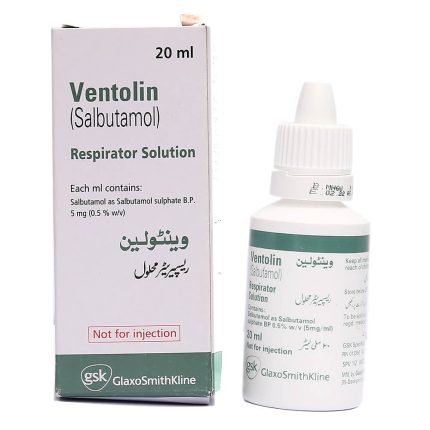VENTOLIN SOLUTION 20ML contains the active ingredient Salbutamol, which belongs to a class of medications known as bronchodilators. It is formulated as an inhalation solution for respiratory use. Salbutamol works by relaxing the muscles in the airways, thereby opening up the air passages in the lungs and making breathing easier.
Uses:
VENTOLIN SOLUTION 20ML is prescribed for the following purposes:
- Relief of Asthma Symptoms: It is used to relieve symptoms of asthma, including wheezing, shortness of breath, chest tightness, and coughing.
- Management of Chronic Obstructive Pulmonary Disease (COPD): Salbutamol may be used to manage symptoms of COPD, such as chronic bronchitis and emphysema, by improving airflow to the lungs.
- Prevention of Exercise-Induced Bronchospasm: It can be used before physical activity to prevent exercise-induced bronchospasm in individuals with asthma or exercise-induced asthma.
- Acute Bronchospasm: Salbutamol may be used to treat acute bronchospasm associated with conditions such as bronchitis or bronchiolitis.
Side Effects:
While VENTOLIN SOLUTION 20ML is generally well-tolerated, some individuals may experience side effects, including:
- Tremor: Salbutamol may cause tremors or shaking, particularly in the hands.
- Palpitations: Some individuals may experience a rapid or irregular heartbeat (palpitations) after using Salbutamol.
- Headache: Headache or dizziness may occur, particularly at higher doses.
- Muscle Cramps: Rarely, Salbutamol may cause muscle cramps or weakness.
- Hyperactivity: In some cases, especially in children, Salbutamol may cause hyperactivity or restlessness.
It is important to seek medical attention if any severe or persistent side effects are experienced.
Precautions:
Before using VENTOLIN SOLUTION 20ML, consider the following precautions:
- Medical History: Inform your healthcare provider about any existing medical conditions, including heart disease, high blood pressure, diabetes, or thyroid disorders.
- Drug Interactions: Salbutamol may interact with certain medications, including beta-blockers, diuretics, or monoamine oxidase inhibitors (MAOIs). Consult your doctor or pharmacist before combining medications.
- Pregnancy and Breastfeeding: VENTOLIN SOLUTION should be used during pregnancy or breastfeeding only if clearly needed and under the guidance of a healthcare professional.
- Children: Use caution when administering Salbutamol to children, and follow the recommended dosage based on age and weight.
When Not to Use:
Avoid using VENTOLIN SOLUTION 20ML if:
- Allergic Reaction: You have a known allergy to Salbutamol or any other ingredients in the solution.
FAQ:
- How should I use VENTOLIN SOLUTION 20ML?
- Follow the dosage instructions provided by your healthcare provider or as indicated on the product label. The solution is usually administered using a nebulizer device for inhalation. Take the prescribed dose as directed, typically 2.5 to 5 milligrams every 4 to 6 hours as needed for relief of symptoms.
- Can VENTOLIN SOLUTION be used for children?
- VENTOLIN SOLUTION may be used in children under the guidance of a healthcare professional. Follow the recommended dosage based on the child’s age and weight.
- How long does it take for Salbutamol to work?
- The onset of action of Salbutamol varies among individuals and depends on factors such as the severity of bronchoconstriction. Relief from symptoms is usually experienced within a few minutes after inhalation, with peak effects occurring within 30 to 60 minutes.
- Can Salbutamol be used as a rescue inhaler?
- Yes, Salbutamol is commonly used as a rescue inhaler to provide rapid relief of acute asthma symptoms or bronchospasm. It should be used as needed for immediate symptom relief, with a maximum recommended dosage specified by your healthcare provider.
- Can Salbutamol be used for long-term asthma management?
- Salbutamol is primarily used for the relief of acute symptoms and should not be relied upon as the sole treatment for long-term asthma management. Long-term control of asthma typically requires the use of controller medications such as inhaled corticosteroids or long-acting bronchodilators.






Reviews
There are no reviews yet.